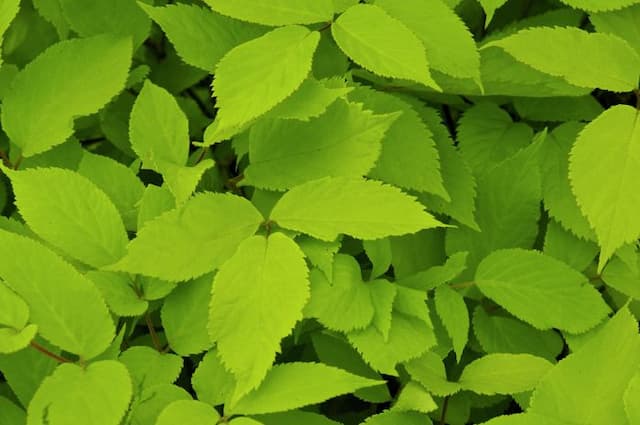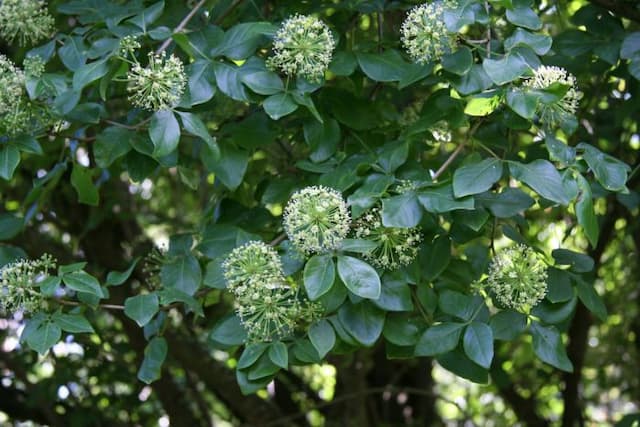Irish Ivy Hedera hibernica 'Deltoidea'

ABOUT
The Hedera hibernica 'Deltoidea', commonly known as the Atlantic or Irish ivy, is appreciated for its ornamental characteristics. It exhibits lush, evergreen foliage that remains vibrant throughout the year. The leaves of this variety are heart-shaped with a broad delta-like base, which gives the 'Deltoidea' its name. Each leaf is glossy and deep green in color, creating a dense mat of greenery when used as ground cover or a rich tapestry when allowed to climb. The tendency of the plant to spread means it can seamlessly cover spaces, either vertically or horizontally, with its flexible stems. These stems are adorned with aerial rootlets that enable the ivy to grip onto surfaces as it grows. In the appropriate conditions, this ivy can produce small, inconspicuous flowers followed by blackish-blue berries, however, these are not commonly observed in cultivated settings. It is the foliage that truly defines the appearance of the Atlantic ivy, characterized by its classic ivy-shaped leaves and the verdant hue they add to landscapes or indoor spaces where the plant is cultivated.
About this plant
 Names
NamesFamily
Araliaceae
Synonyms
Irish Ivy, Atlantic Ivy
Common names
Hedera hibernica 'Deltoidea'.
 Toxicity
ToxicityTo humans
Irish ivy is known to be toxic to humans if ingested. All parts of the plant contain saponins and polyacetylene compounds, which can cause poisoning. Symptoms of Irish ivy poisoning can include abdominal pain, vomiting, and diarrhea. In some cases, contact with the skin can lead to dermatitis. If the sap gets in the eyes, it can result in eye irritation or damage. Ingesting large amounts of the plant can potentially cause severe toxicity, leading to breathing difficulties, convulsions, or coma.
To pets
Irish ivy is also toxic to pets, including dogs and cats. Similar to its effects on humans, ingesting any part of the plant can lead to poisoning. Symptoms of toxicity in pets can include vomiting, abdominal pain, hypersalivation, and diarrhea. In severe cases, consuming Irish ivy might lead to symptoms such as muscle spasms, difficulty breathing, or even coma. Pets should be kept away from the plant to avoid accidental ingestion.
 Characteristics
CharacteristicsLife cycle
Perennials
Foliage type
Evergreen
Color of leaves
Green
Height
6-50 feet (1.8-15 meters)
Spread
3-50 feet (0.9-15 meters)
Plant type
Climber
Hardiness zones
5-9
Native area
Europe
Benefits
 General Benefits
General Benefits- Enhances Aesthetics: Adds lush greenery and texture to landscapes and indoor spaces.
- Grows in Shade: Thrives in shaded areas where other plants may struggle.
- Easy to Care For: Requires minimal maintenance, making it ideal for busy or novice gardeners.
- Soil Erosion Control: Helps prevent soil erosion by stabilizing the ground with its root system.
- Versatile Planting: Can be used for ground cover, climbing walls, or trailing from hanging baskets.
- Privacy Screen: When used as a climber, it can create a dense screen, offering privacy.
- Wildlife Shelter: Provides shelter and breeding sites for various species of birds and insects.
 Medical Properties
Medical PropertiesThis plant is not used for medical purposes.
 Air-purifying Qualities
Air-purifying QualitiesThis plant is not specifically known for air purifying qualities.
 Other Uses
Other Uses- Hedera hibernica, commonly known as Irish Ivy, can be used as a natural dye for fabrics; the leaves contain tannins that can produce subtle, earth-toned colors.
- Ivy can be woven into baskets and other decorative items due to its flexible stems that can be manipulated when soaked.
- As a ground cover, Irish Ivy helps to prevent soil erosion on slopes due to its network of roots that hold the soil in place.
- Irish Ivy is sometimes used in topiary to create living sculptures, as it can easily be trained to climb frames and molds.
- The dense foliage of Irish Ivy can provide a shelter for wildlife, such as birds and small mammals, offering them a protective habitat.
- Ivy plants have been used in landscape photography, providing lush green backdrops that enhance the aesthetic appeal of the photograph.
- The plant is used in festive decorations, especially during the Christmas season, as it symbolizes eternity and resurrection.
- The ivy can be used for educational purposes, studying plant growth, climbing mechanisms, and responses to pruning in a controlled environment.
- Culinary arts occasionally utilize the aesthetic appeal of Ivy by incorporating its leaves into presentation and plating, although it should be noted that the leaves of this plant are not edible.
- Some artisans craft living wreaths using Irish Ivy, where its enduring verdancy is appreciated for lang-lasting natural decor.
Interesting Facts
 Feng Shui
Feng ShuiThe Atlantic Ivy is not used in Feng Shui practice.
 Zodiac Sign Compitability
Zodiac Sign CompitabilityThe Atlantic Ivy is not used in astrology practice.
 Plant Symbolism
Plant Symbolism- Protection: Hedera hibernica, commonly known as Irish Ivy, is often associated with protection due to its dense, evergreen foliage, which provides shelter and coverage throughout the year.
- Fidelity: The clinging nature of Irish Ivy’s vines symbolizes fidelity and attachment, reflecting the plant’s ability to stick firmly to structures and surfaces.
- Friendship: Irish Ivy's longevity and its propensity to intertwine with other plants can represent the lasting, interconnected bonds of friendship.
- Perseverance: Given its hardy nature and ability to thrive in challenging conditions, Irish Ivy is seen as a symbol of perseverance and resilience.
- Eternal life: As an evergreen, Irish Ivy symbolizes eternal life or immortality, indicating the persistence of the soul beyond physical existence.
- Memory: It is sometimes used in commemoration, as its enduring quality can be seen to represent enduring memory and remembrance.
 Water
WaterThe Atlantic Ivy should be watered thoroughly when the top inch of soil feels dry to the touch. This might equate to watering every 7 to 10 days, depending on indoor conditions and seasonal changes. Each watering should be sufficient to moisten the soil thoroughly, which often means using approximately half a gallon for a medium-sized plant. It's important to let any excess water drain away to prevent root rot. During the dormant season in winter, reduce watering frequency while ensuring the soil doesn't completely dry out.
 Light
LightAtlantic Ivy thrives in a location with bright, indirect light for the majority of the day. It can also adapt to low-light conditions, making it suitable for less sunny spots. However, avoid exposure to direct afternoon sunlight, which could scorch the leaves. A north or east-facing window is typically an ideal spot for this plant.
 Temperature
TemperatureAtlantic Ivy does best in temperatures ranging from 50 to 70 degrees Fahrenheit but can survive in temperatures as low as 30 degrees and as high as 80 degrees Fahrenheit. Avoid placing the plant in areas with drafts, sudden temperature changes, or close to heating and cooling vents to maintain a consistent environment.
 Pruning
PruningPruning Atlantic Ivy is mainly done to maintain its shape, control its size, and encourage denser foliage. It's best to prune in the spring or summer when the plant is actively growing. Periodic pruning, a few times a year, by cutting back overlong vines, can help keep the plant looking tidy.
 Cleaning
CleaningAs needed
 Soil
SoilThe Irish Ivy (Hedera hibernica 'Deltoidea') thrives in a soil mix that is rich in organic matter, well-draining, and has a pH of 6.0 to 7.5. A mix of loam, peat or compost with perlite or vermiculite is ideal to provide the necessary nutrients and drainage.
 Repotting
RepottingIrish Ivy should be repotted every two to three years to ensure it has enough room to grow and to refresh the soil. Younger, more actively growing plants may require more frequent repotting.
 Humidity & Misting
Humidity & MistingIrish Ivy prefers high humidity levels but is adaptable to average indoor humidity. Providing humidity levels of 40% to 60% will keep the plant thriving.
 Suitable locations
Suitable locationsIndoor
Place in bright, indirect light and keep soil moist.
Outdoor
Plant in part-shade, shelter from strong winds.
Hardiness zone
5-11 USDA
 Life cycle
Life cycleIrish Ivy 'Deltoidea' begins life as a seed, which upon germination, develops a small root system and cotyledons for nutrient absorption and photosynthesis, respectively. It then enters the vegetative stage, where it produces a vigorous growth of broad, glossy, three-lobed, dark green leaves and trailing or climbing stems that attach to surfaces with aerial rootlets. The plant matures over several years, forming dense foliage covers in its preferred partial to full shade environments. Irish Ivy may produce small, inconspicuous yellow-green flowers in mature plants followed by dark berries which are rarely observed in cultivation. Reaching maturity, it can enter a reproductive phase annually if conditions are favorable. Once the plant has completed its lifespan, which can be several decades in ideal conditions, it dies back, leaving seeds to start the next generation.
 Propogation
PropogationPropogation time
Spring-Early Summer
Propogation: The Irish Ivy 'Deltoidea' is often propagated through stem cuttings. To do this, a gardener can take a stem cutting of around 4 to 6 inches (10 to 15 centimeters) during the spring or early summer when the plant's growth is most active. The bottom leaves of the cutting are removed, and the cut end is dipped into rooting hormone to encourage root development. The cutting should then be placed into a pot filled with a moistened mixture of peat and perlite or sand to provide good drainage. The pot should be kept in a warm location with indirect light and the soil should be kept consistently moist. Roots will typically develop within a few weeks, after which the new plant can be transplanted into its permanent location.









